
| Home | Source Reduction | Friends of Green Friends | Newsletters |
| Gardening | Resources | What You Can Do | Embracing The Trees |
| Lessons I Learned from Gardening | |||
|
|||
|
Patience "Patience, constant enthusiasm and firm determination are necessary factors for success." - Amma Every part of the gardening process teaches us patience. For most plants, starting seeds requires weeks to months of patiently waiting for the first shoots to appear. How much joy and hope there is on seeing those tiny little green shoots sticking out the soil. In the cold and often gloomy New England spring those first signs of life brought me much joy. |
|||
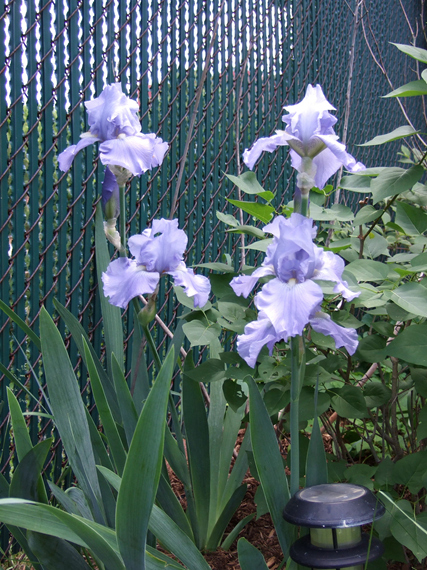 |
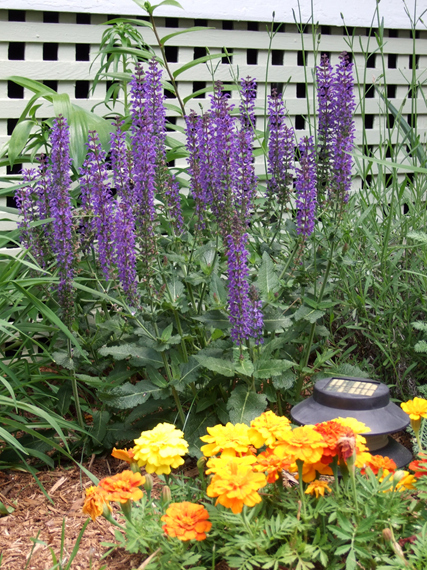 |
||
|
Spring Irises and Summer Salvia and Marigolds
|
|||
|
Then comes the waiting period for the last frost to pass. While many cool weather crops can be planted before the last frost, many vegetables require waiting till after so as not damage or kill the tender seedlings. Once everything is planted, comes the daily waiting for the first blooms, then the tiny vegetables. Once those are spotted, then waiting for the vegetables to ripen or mature and ready to be picked. |
|||
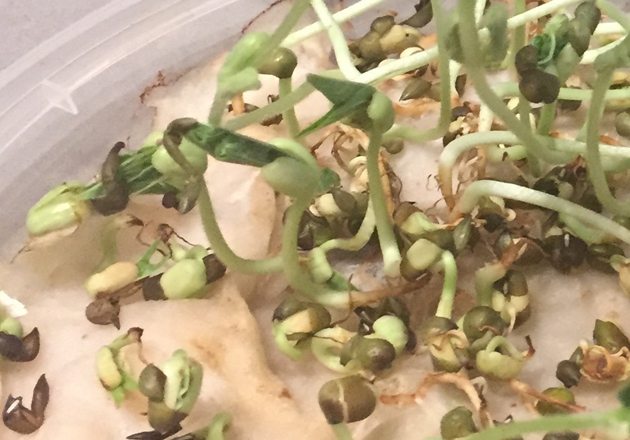 |
|||
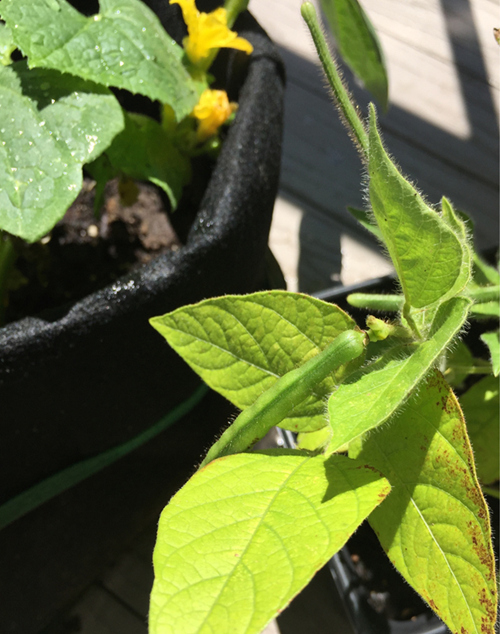 |
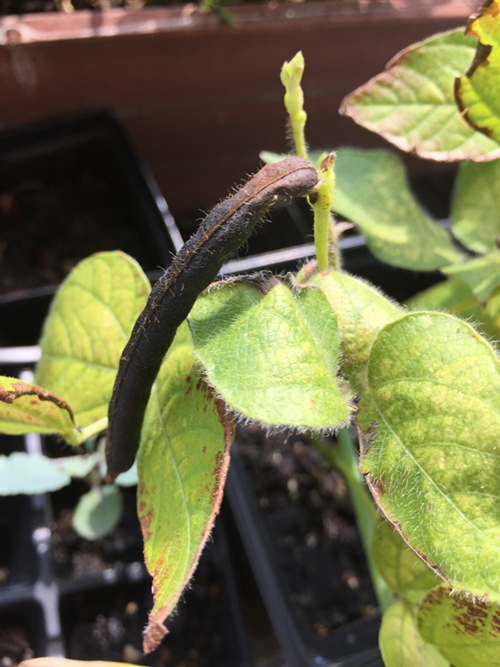 |
||
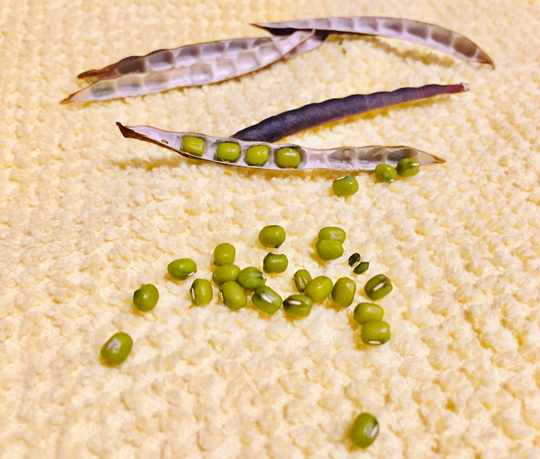 |
|||
|
Mung beans started from beans, with seed pods, ready for picking (when dark), and finally harvested
|
|||
|
In the fast paced world we have become accustomed to living in, plants and vegetables teach us that everything happens in its due course - that too much or too little at the wrong time can be disastrous to the crop and time does bear fruit. "Attachment is loading the mind and detachment is unloading the mind." - Amma Detachment The hardest part of being a gardener has been to let go of seeds that did not become seedlings, seedlings that did not survive and plants that died due to environmental conditions like pests or for unknown reasons. With every plant that I lost, I mourned the loss, but it did not prevent myself from continuing. I did more research. I thought about whether I could have done anything differently and then I moved on. I tried growing Hydrangeas for several years in a row. I thought I had found a spot in my garden with the right amount of light. After they didn’t survive the first year, I tried amending the soil. That didn’t work. I researched its water needs and tried to do things differently the third year but finally decided that for that garden, Hydrangeas were just not going to work. I grew many other varieties of beautiful flowering plants over the years there. |
|||
|
Prevention "The love of awakened motherhood is a love and compassion felt not only towards one’s own children, but towards all people, animals and plants, rocks and rivers—a love extended to all of Nature, all beings." - Amma The first year I planted tomato seedlings, after a few days I found several plants flopped to the ground. On doing research I found out about cutworms. They live in the soil and like to eat the stems of tender plants. I learnt to put a collar of an impenetrable material around the plant when putting them in the ground. I also learnt that planting marigolds with tomato plants helps keep certain parasites called nematodes away from the roots. The next year, I had many beautiful round eggplants almost ready for picking. The garden plot was inside a fence. I walked in one day to find every single eggplant had a huge bite taken out of it. On looking at the fence, I realized that some creature had dug a hole underneath the fence to get in. I surrounded the plants with their own mini fences. II have a balcony garden now, and given the very hot and dry summer we have been having here, I found a webbing on my zucchini plants. A very knowledgeable friend helped me identify the issue to be spider mites. I sprayed the underside of all the leaves with water to break their reproductive cycle and wiped off as many of them as I could from the bottom of the leaves. I also keep finding aphids on my collard plants and have to keep washing them off. Now I check the plants regularly and spray the leaves with water on hot dry days. |
 Aphids on the underside of the collard seedlings |
|
And it is possible that in spite of these actions, I may lose the plant. At which point I will release my attachment to seeing the end results. The leaves of my tomato plants started turning yellow and I thought I had been overwatering them. But when I was showing my friend photos of the webbing, she mentioned that my tomato plants were hungry and needed fertilizer. After applying an organic fertilizer to the soil, their leaves have started turning green. |
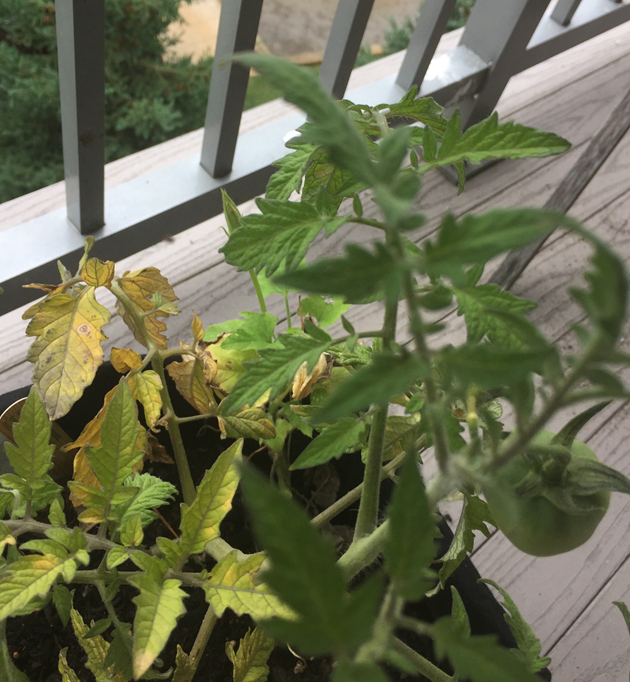 Yellow leaves on the tomatos |
|
Timing "The nature of the world is one of change." - Amma There is a time and place for everything. In the spring when I first started building flower beds, I went to the nurseries and bought pots of blooming flowers. Over the years, I understood that plants sold at nurseries (especially at big box stores) are meant to be in bloom at the time they are put outside. Their blooms don’t always last for the full growing season. So I started visiting nurseries at least once each season to see what was blooming and how long the flowering season was for the plants that were blooming. After a few years, I was able to create a beautiful 3-season garden where different clusters of plants were always in bloom. |
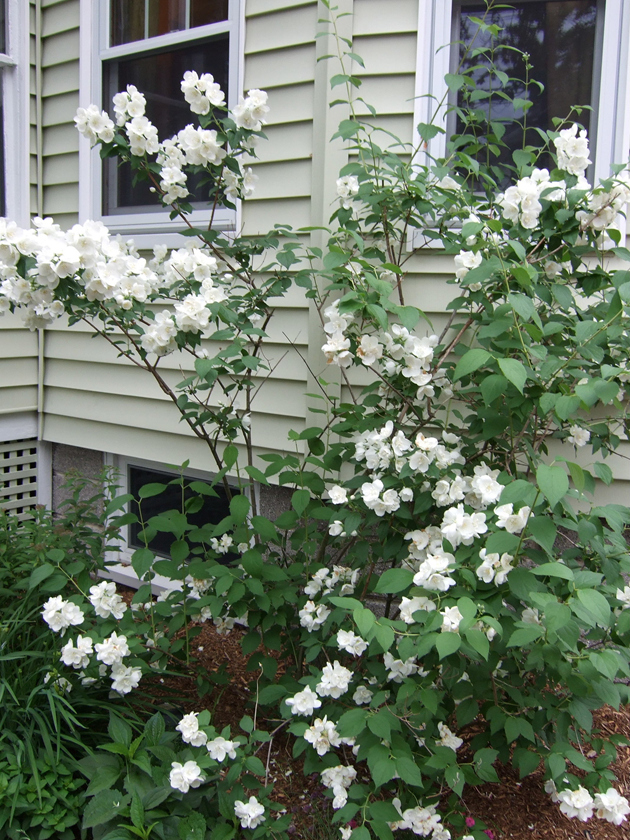 Fragrant Mock Orange in the late Spring |
|
I also ordered flowering trees like Rose of Sharon and Lilacs from an inexpensive catalog. When they arrived they were just foot-long twigs. I followed the instructions and planted them. 12 years later when I sold that home, the Rose of Sharon trees were 20 feet high and the Lilac bush was 8 feet tall putting out many fragrant clusters of lilac flowers every spring. |
 Late Spring Lilacs |
| Too Much of a Good Thing
"Beware; your actions in the present determine your future." - Amma My philosophy has generally been to “Live and let Live” and “Anything goes”. But in the world of gardening as in life, that idea doesn’t always work. The first time I grew okra plants, I got many beautiful okras. I let them grow and grow and grow. If you have ever grown okra, you already know how this story ends. Okra needs to be picked when tender. If you leave it too long, it becomes woody and inedible. You have to know how much fertilizer to apply. If you apply too much, you can burn the plants especially if you apply it to the leaves when you should be applying to the soil. As a vegan, I have a very hard time killing living things. But when you find pests on your plants you need to get rid of them immediately or things can get bad quickly. Many plants benefit from pruning. Tomatoes have auxiliary stems called suckers that take up nutrients and cause smaller tomatoes even if more of them. Removing the suckers gives bigger tomatoes. |
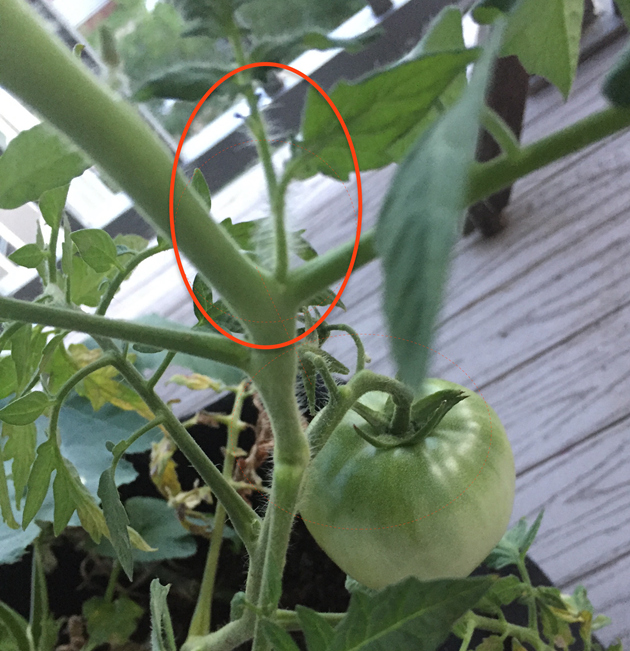 Sucker that should be picked in red circle |
|
Deadheading flowers before they go to seed (unless you want seeds), allows the plant to produce more flowers instead of spending energy making seeds. Plants like Peonies and Tomatoes need stakes or cages to support them. Without support, they will flop over. It is important to support the plants before they get too big otherwise they will bend from the weight and supporting them once bent is a lot harder. Some trees drop helicopter seeds all over the lawn and flower beds. In the case of Maple seeds, they grow into shoots very quickly, and the roots can run very deep and grow thick fast. If you don’t pull them out when the shoots are a few inches, taking them out is a lot of work. If you don’t pay attention, you may suddenly have a maple tree growing in your flower bed. |
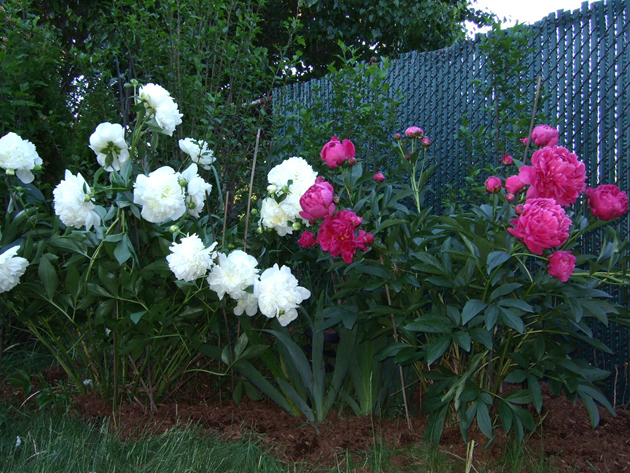 Peonies with stakes |
| Being a gardener is an emotional journey. There will be loss but also lots of beauty and joy. You never stop learning and the constantly changing environmental conditions are always waiting to challenge you. Perseverance, patience, preventative care, detachment, timely action and knowledge can go a long way to helping you along your gardening journey.
A gardener - Boston, MA |
Read Milk Crate Composting from the Summer 2020 newsletter >>
| Home | Source Reduction | Friends of Green Friends | Newsletters | Resources | What You Can Do | Contact Us |
For more information, e-mail info@greenfriendsna.org |
||||||